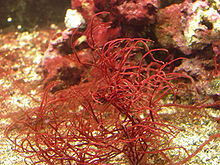- Gracilaria
-
Gracilaria Scientific classification Domain: Eukaryota (unranked): Archaeplastida Phylum: Rhodophyta Class: Florideophyceae Order: Gracilariales Family: Gracilariaceae Genus: Gracilaria
Greville, 1830Gracilaria is a genus of red algae (Rhodophyta) notable for its economic importance as an agarophyte, as well as its use as a food for humans and various species of shellfish. Various species within the genus are cultivated in various parts of the developing world, including Asia, South America, Africa and Oceania.
Contents
Distribution
Gracilaria bursa-pastoris (S.G.Gremlin) Silva and Gracilaria multipartita (Clemente) Harvey have long been established in southern England and northwestern France, but confusion between Gracilaria gracilis (Stackhouse) Steentoft, L.Irvine & Farnham and Gracilariopsis longissima (S.G.Gmelin) Steentoft, L. Irvine & Farnham, (as Gracilaria verrucosa (Hudson) Papenfuss or Gracilaria confervoides (L.) Greville) (Steentoft et al. 1995), has prevented recognition of the northern boundaries.[1]
Use
Gracilaria is used as a food in Japanese, Hawaiian, and Filipino cuisine. In Japanese cuisine, it is called ogonori or ogo. In the Philippines, it is called gulaman or guraman.[2]
See also
References
- ^ Steentoft, M. and Farham, W.F. 1997. Northern distribution boundaries and thermal requirements of Gracilaria and Gracilariopsis (Gracilariales, Rhodophyta) in Atlantic Europe and Scandinavia. Nord. J. Bot. 5: 87 - 93
- ^ Davidson, Alan (2004). Seafood of South-East Asia: A Comprehensive Guide with Recipes. Ten Speed Press. pp. 197. ISBN 978-1-58008-452-9.
External links
Categories:- Red algae
- Edible algae
- Seaweeds
- Rhodophyta stubs
Wikimedia Foundation. 2010.

